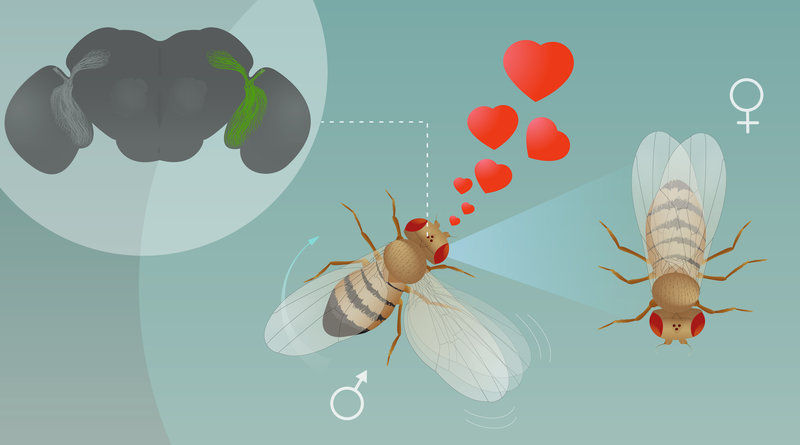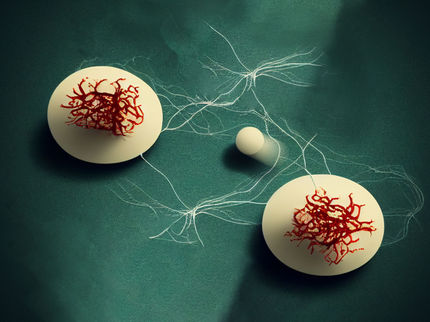How visual information about females reaches the male brain
LC10 – the neuron that tracks fruit flies
Advertisement
Many animals rely on vision to detect, locate, and track moving objects. Male Drosophila fruit flies primarily use visual cues to stay close to a female and to direct their courtship song towards her. Scientists from the Max Planck Institute of neurobiology in Martinsried and the Janelia Research Campus (USA) now described the nerve cells, which allow the detection and tracking of a moving female. The results suggest that these LC10 cells constitute an essential pathway to relay visual information that is necessary for efficient courtship in fruit flies.

LC10 visual projection neurons are essential to recognize and visually track a female fruit fly during courtship.
MPI für Neurobiologie/ Kuhl
The first step towards a successful mating is to recognize a potential mate. To estimate the species, gender and receptivity of a potential mate, male fruit flies use their sense of smell and taste. If the results are promising, the male turns toward the female, and extends and vibrates one wing toward her. This "wing song" that the male sings while he follows the female is an essential part of the courtship ritual. Yet, how the brain extracts something like "potential mate" from the visual clues and initiates a target-oriented behavior, remains poorly understood.
Scientists from the department of Alexander Borst at the Max Planck Institute of Neurobiology and Barry Dickson at Janelia Research Campus investigated this question in the fruit fly. "The eyes "see" merely two-dimensional changes in light intensity varying across space and time", explains Ines Ribeiro, the first author of the study. "From this information, the brain first needs to extract the shape of another fly, a potential mate, and then has to coordinate its movements to direct his behavior at the target. That's incredibly complex."
In the insect brain, visual projection neurons relay the pre-processed information from the eyes to areas in the central brain. It is known, that some classes of visual projection neurons play a role in mate recognition and tracking in fly species where the male pursues the female in flight, such as houseflies and blowflies. These cells could thus also play a respective role in the fruit fly brain. However, the cell types described so far respond only to small moving objects. As the fruit fly male courts close to the female, she takes up much of his visual field, making her too large for the known visual projection neurons. "So we set out to find another type of visual projection neuron, fitting to the needs in Drosophila", says Ines.
A promising candidate seemed to be the so-called LC10 cells, whose specificity was yet unknown. The scientists could show in behavioral assays that LC10 cells proved sufficient and necessary for males to stay at the side of a female and to extend the wing facing her. These cells reacted to moving objects of the size of a fly. In fact, “LC10 cells seem to extract object motion relative to the background, which makes these cells robust object detectors in cluttered natural visual scenes”, explains Michael Drews, the study's co-author. In addition, the results indicate that LC10 cells recognize the current position of a potential mate. With this information, downstream brain circuits facilitate female tracking. The frequency and duration of wing extensions by the male was influenced by his state of courtship arousal. If the so-called P1 neurons, which only exist in males, were pre-activated in the male brain artificially or by female pheromones, the effectivity of the LC10 cells was greatly enhanced and thus the males' visual tracking and wing extension.
The results show that the LC10 cell type of the visual projection neurons are both necessary and sufficient for visually-guided aspects of male courtship behavior. In the vertebrate brain, retinal ganglion cells undertake similar tasks as the visual projection neurons. It is thus possible that a type of retinal ganglion cells provides a causal link between vision and an object-targeted behavior as well. This could be in courtship, prey capture or for a different directed interaction.
























































